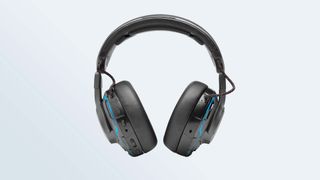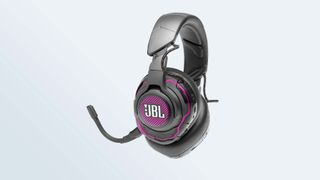Tom's Guide Verdict
The JBL Quantum One gaming headset offers a comfy fit and good sound quality but we wish the price was more affordable.
Pros
- +
Great sound
- +
Noise-canceling options
- +
Works with any system
Cons
- -
Very expensive
- -
Frustrating setup
- -
3D sound doesn’t add much
Why you can trust Tom's Guide
Price: $300
Compatibility: Mobile, PC, PS4, Switch, Xbox One
Drivers: 50 mm dynamic
Frequency Response: 20 Hz - 40 kHz
Wireless: No
The JBL Quantum One represents the company’s first foray into gaming headsets. JBL is a household name when it comes to high-end audio equipment. From headphones, to speakers, to studio accessories, there’s a good chance that JBL makes something to enhance your home audio experience. If anything, it’s odd that the company has never tried to make a gaming headset before, since nuanced soundscapes and clear mics are pretty much JBL hallmarks.
As such, it’s no great surprise that the Quantum One sounds great and lets you communicate clearly. It’s fairly comfortable, and blocks out more external sound than a standard gaming headset. However, the headset’s novel extra features don’t quite justify its astronomical price tag. The Quantum One is simply a tough sell for $300, even though I liked most of the product’s individual components.
- Also consider the best headphones
- The best computer speakers may also work for your setup
If you’re looking for a highly customizable gaming headset that can also handle 3D sound and Hi-Res Audio, our JBL Quantum One review will explain why it's worth considering, at least if the idea of spending $300 on an audio accessory sits well with you. Otherwise, it doesn't really stand out enough to be one of the best gaming headsets.
JBL Quantum One: Design
The Quantum One looks like a very complicated piece of hardware. Every part of it looks intricately designed, from its black plastic chassis with scale-like engravings on the headband and earcups, to its orange-and-black braided cable. It’s a large headset, weighing 13 ounces, and featuring a massive headband and earcups. It’s not quite overdesigned enough to be obnoxious, but it’s a definite reversal of the trend toward sleek, small peripherals that we’ve seen in other gaming headsets.

There are a lot of ways to manipulate the headset's audio, too. The right earcup has a button to activate noise canceling, a button to center head-tracking (more on this later), a volume dial, a mic mute button, a USB-C port, a 3.5 mm audio port and a proprietary port for a removable, flexible mic.

There’s also a small chat/game balance mixer dial that sits on your desk. It has a non-adhesive platform that provides friction, but in my experience, it’s still pretty easy to knock the dial out of place. It also moves when you pull the headset too much in one direction or another. I would have been much happier to use the headset without the dial, but that doesn’t appear to be an option, at least if you use the included USB cable.

Of course, you can also connect via 3.5 mm audio cable, which you’ll need to do for systems like the Xbox One, or the Nintendo Switch in handheld mode. (JBL recommends using the 3.5 mm connection for the PS4, but the USB connection for the Switch in docked mode, which is baffling, since the PS4 likes most USB headsets just fine.)
In short, there’s a lot that you can do with the Quantum One. That’s sometimes to the device’s credit, and sometimes to its detriment.
JBL Quantum One: Comfort
The first thing I noticed about the JBL Quantum One is that it has a much tighter fit than most gaming headsets. The over-the-ear cups made a very snug seal around my ears. At first, I was worried that this might feel uncomfortable after a while, particularly since I wear glasses. But while the headset did press down a little harder than I liked, it never got painful, or even particularly bothersome.

In fact, I found I actually liked the tight seal, because it blocked so much noise from the outside. When I first put the headset on, my partner was watching a TV show a few feet away. As soon as the Quantum One came down around my ears, the show became almost inaudible, and I was left in my own world of video games and classical music. The Quantum One does have electronic noise-canceling features, too, but you may not even need to activate them.
The only thing I didn’t really like about the Quantum One’s fit was that it uses an old-fashioned series of plastic notches rather than a more attractive steel band or a more intuitive elastic band. The notches aren’t numbered, either, so finding your perfect fit is very much a matter of trial and error; remembering it after the fact, even more so.
As the Tom’s Guide office is currently closed, I couldn’t hand the device over to a coworker to compare comfort notes. However, my colleague Scharon Harding at Tom’s Hardware shared my assessment of the earcups as being tighter than she expected. She found them uncomfortable after a few hours, but she also has longer hair and thicker glasses frames than I do, so bear that in mind before you take the plunge.
JBL Quantum One: Gaming performance
I tested the Quantum One with Doom Eternal, Shadow of the Tomb Raider, Age of Empires II: Definitive Edition and World of Warcraft to see how well the device performed across multiple genres. Generally speaking, the headset provided gorgeous, robust sound. Slavering demons in Doom Eternal, obedient villagers in Age of Empires, ancient death traps in Tomb Raider and whirling blades in World of Warcraft all sounded vibrant and lifelike. The way the Quantum One balanced dialogue, music and sound effects was also effective, letting me hear all three without deemphasizing any of them.

You can also customize your gaming experience to a significant degree, thanks to the JBL QuantumENGINE software. This program comes with a variety of preinstalled equalization options, including ones that optimize the soundscape for FPS gameplay, or even long play sessions. You can also toggle surround and 360 sound — neither of which is great, but it’s nice to have the option.
JBL Quantum One: Features
This is where the JBL Quantum One’s reach exceeds its grasp. The headset promises a tremendous variety of features, all of which theoretically help justify its $300 price tag. With the QuantumENGINE software, you can set equalization options, customize RGB lighting (the earcups have elaborate lighting patterns — it’s pretty but unnecessary), tweak mic levels and activate spatial sound options. There’s no way to create individual profiles or link them with games, so you’ll have to micromanage your experience for each new app.

The spatial sound is the defining feature of the Quantum One, and we’ll get to that shortly. But first, I do have to point out how absolutely miserable the setup process is for this headset. In five years of reviewing headsets, I can’t recall another peripheral that had a more confusing, convoluted setup, or a less intuitive troubleshooting process. And yes, this is a known issue: JBL sent along a very long list of instructions with the headset, just to ensure that I’d get it right. (I managed to mess it up anyway, which should give you an idea of just how tenuous it can be.)
Without going into exhaustive detail, the Quantum One uses three separate drivers to install on Windows, and you have to manually uninstall, then reinstall all of them. The proper driver requires you to manually tweak advanced sound options in the control panel; without this, you can’t get surround sound. But when I switched to the correct driver, the Quantum One stopped producing sound altogether. To fix this problem, I had to uninstall and reinstall six different drivers, as well as the QuantumENGINE software — but even that alone didn’t do anything. In abject frustration, I factory reset the device, whereupon everything worked fine. Plug-and-play, this is not.

It’s a good thing that the Quantum One is aimed toward audiophiles, because I can’t imagine a casual gamer ever tolerating an installation process like this.
Once everything is up and running, though, you’ll be able to make use of QuantumSPHERE 360: a JBL technology that tracks your head and adjusts your surround sound accordingly. In theory, this can be quite immersive. In practice, it’s not nearly as noticeable as the 3D sound in the HyperX Cloud Orbit S headset. And, the fact remains that even during the most heated FPS level, my head never appreciably changed its orientation. Perhaps if you have a gigantic curved monitor, 3D sound can add a lot to a game, but otherwise, you’d be surprised just how stationary your head stays while you stare at a fixed point. It’s an interesting technology, but I just don’t think it merits the kind of money that these headsets require.
JBL Quantum One: Music performance
Since JBL is primarily a music accessories company, it will come as no surprise that the Quantum One does a great job with all kinds of music. I listened to tracks from Flogging Molly, Old Crow Medicine Show, The Rolling Stones and G.F. Handel. In each case, the vocals were bright and clear, and the instruments were resonant and lifelike.

The Quantum One also comes with Hi-Res Audio certification; a rarity among gaming headsets. Without going into tremendous detail about what this entails, it means that if you can find lossless audio files, the Quantum One can play them in full fidelity. It’s an expensive way to listen to your favorite tracks, admittedly, but if you’re the kind of person who likes to sit back and listen to music for its own sake, no distractions, it might be worth the Quantum One’s premium price.
JBL Quantum One: Verdict
Our JBL Quantum One review contends that the gadget's fundamentals work well. It sounds great, and it’s pretty comfortable to wear. You can customize it to suit your favorite games, and you can use it with just about very system on the market.
On the other hand, it’s quite expensive, considering the frustrations involved with setup and maintenance. Furthermore, its star feature is underwhelming, and, at least in my experience, doesn’t add much to the games it’s supposed to enhance.
At $300, the Quantum One is tough to recommend, although if you can stomach the price, it’s not at all a bad headset. What’s more interesting to me, though, is JBL’s whole upcoming line of headsets, which start at $40 and comprise more than half-a-dozen different options. I don’t know if the Quantum One strikes the right balance between price and features, but I think one of the others just might.
- More: Check out our full JBL Quantum 800 review
Marshall Honorof is a senior editor for Tom's Guide, overseeing the site's coverage of gaming hardware and software. He comes from a science writing background, having studied paleomammalogy, biological anthropology, and the history of science and technology. After hours, you can find him practicing taekwondo or doing deep dives on classic sci-fi.

